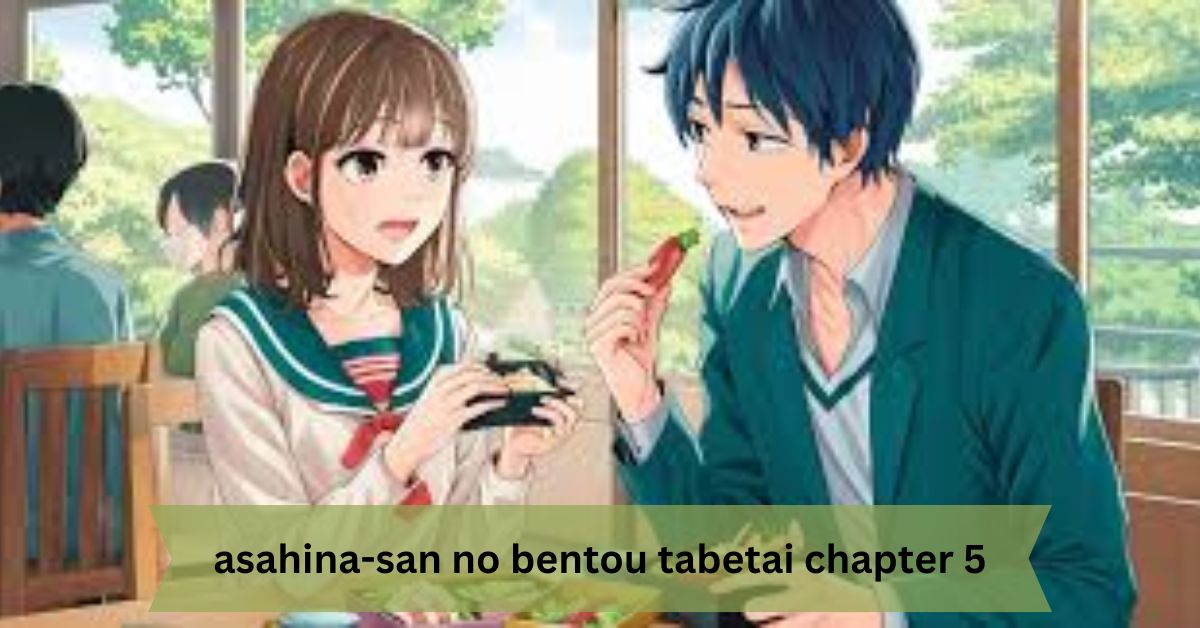In the heartwarming world of “Asahina-san no Bentou Tabetai,” Chapter 5 brings us a fresh blend of creativity, emotion, and culinary artistry. This chapter, which focuses on Asahina-san facing a new culinary challenge, is particularly noteworthy for its portrayal of the art of bento-making.
What Is “Asahina-san no Bentou Tabetai”?
For those unfamiliar with the series, “Asahina-san no Bentou Tabetai” is a popular manga that revolves around the life of Asahina-san, a young woman who finds joy and meaning in creating intricate and thoughtful bento boxes.
Each chapter showcases different themes, emotions, and challenges, all encapsulated within the art of bento-making. The series is not just about food; it’s about the connections and memories that food can evoke.
Overview of Chapter 5
In Chapter 5, titled “The Seasons in a Box,” Asahina-san is tasked with creating a bento that captures the essence of the changing seasons.
This challenge is significant because it goes beyond simply preparing food; it requires Asahina-san to think deeply about what each season represents and how to convey that through her cooking. The chapter is a beautiful exploration of creativity, tradition, and the passage of time.
The Significance of the Seasons in Japanese Culture
Before diving into the details of the bento, it’s important to understand the cultural significance of the seasons in Japan. In Japanese culture, the changing of the seasons is celebrated through various festivals, rituals, and, of course, food.
Seasonal ingredients are highly valued, and the Japanese take great pride in showcasing these ingredients in their cuisine.
In this chapter, Asahina-san’s challenge is to encapsulate this deep cultural appreciation for the seasons within the confines of a single bento box. This task is not only about aesthetics but also about evoking the emotions and memories associated with each season.
The Process of Creating the Seasonal Bento
1. Spring: The Season of Renewal
Spring in Japan is synonymous with cherry blossoms (sakura), a symbol of new beginnings. Asahina-san starts her bento by incorporating ingredients that represent the freshness and vitality of spring. Pink rice, colored with sakura petals, is shaped into delicate cherry blossoms. Fresh green vegetables, symbolizing the new growth of spring, are arranged artfully around the rice.
Asahina-san also includes slices of bamboo shoots, a traditional spring ingredient in Japan. The bamboo shoots represent resilience and strength, qualities that are often associated with the season of renewal.
The overall effect is a bento that not only looks like spring but also tastes like it, with each bite offering a reminder of the season’s freshness.
2. Summer: The Season of Energy
Summer in Japan is hot and vibrant, full of festivals, fireworks, and beach outings. To capture the essence of summer, Asahina-san turns to ingredients that are both refreshing and energizing.
She uses cold somen noodles, which are a popular summer dish in Japan, as the base for this section of the bento. The noodles are topped with thin slices of cucumber and grated ginger, providing a cool and zesty flavor that is perfect for a hot summer day.
Asahina-san also includes grilled eel (unagi), a traditional summer food in Japan known for its rich, bold flavor. The eel is believed to provide stamina during the hot summer months, making it a fitting choice for this season’s bento.
The colors in this section are vibrant, with the green of the cucumber and the golden brown of the eel evoking the energy and warmth of summer.
3. Autumn: The Season of Harvest
Autumn is a season of abundance in Japan, with a wide variety of fruits, vegetables, and grains coming into season. Asahina-san’s autumn bento reflects this abundance with an array of seasonal ingredients. She starts with chestnut rice, a traditional autumn dish, which is both hearty and comforting.
The bento also includes slices of roasted sweet potatoes, a staple of autumn cuisine in Japan. The sweet potatoes are glazed with a touch of honey, enhancing their natural sweetness and adding a rich, golden hue to the bento.
To complete the autumn theme, Asahina-san adds a few pieces of grilled mackerel, a fish that is at its best during the fall months.
The colors in this section are warm and earthy, with the browns and oranges of the ingredients reflecting the changing leaves of autumn. Each bite of this bento is meant to evoke the cozy, comforting feeling of the fall season.
4. Winter: The Season of Reflection
Winter in Japan is a time for reflection and introspection. The days are shorter, and the cold weather encourages people to stay indoors and enjoy warm, comforting meals. Asahina-san’s winter bento is designed to provide both warmth and nourishment, using ingredients that are hearty and satisfying.
She starts with a base of steamed rice, topped with a rich, savory miso sauce. The miso, which is made from fermented soybeans, is a traditional winter food in Japan, known for its warming properties. Asahina-san also includes slices of simmered daikon radish, a winter vegetable that is both tender and flavorful.
To add a touch of sweetness, she includes a few pieces of simmered kabocha (Japanese pumpkin), which has a natural sweetness that is enhanced by slow cooking. The colors in this section are subdued, with the whites and browns of the ingredients reflecting the quiet, still nature of winter.
Analyzing the Themes of Chapter 5
1. The Passage of Time
One of the central themes of Chapter 5 is the passage of time, as represented by the changing seasons. Asahina-san’s bento is not just a meal; it’s a visual and culinary representation of time itself. Each section of the bento captures the essence of a different season, reminding the eater of the cyclical nature of life.
This theme is particularly poignant in Japanese culture, where the passage of time is often reflected in the changing of the seasons. The bento serves as a reminder that time is always moving forward, and that each season, with its unique characteristics and flavors, is a moment to be cherished.
2. The Art of Bento-Making
Chapter 5 also highlights the artistry involved in bento-making. Asahina-san’s bento is not just about taste; it’s about creating a visual and emotional experience.
The careful selection and arrangement of ingredients, the attention to color and texture, and the thoughtful incorporation of seasonal themes all contribute to the bento’s overall impact.
In Japan, bento-making is often seen as an art form, with each bento telling a story or conveying a message. Asahina-san’s bento in this chapter is a perfect example of this, as it tells the story of the seasons and the passage of time through the medium of food.
3. Cultural Significance
The chapter also delves into the cultural significance of the seasons and seasonal ingredients in Japan. Asahina-san’s bento is a reflection of the deep connection that the Japanese people have with nature and the changing seasons.
By using seasonal ingredients, she not only honors this tradition but also creates a meal that is in harmony with the natural world.
This cultural significance is something that readers outside of Japan may not fully appreciate, but it’s an essential part of the story. The chapter serves as a window into Japanese culture, offering readers a glimpse into the importance of seasonality in Japanese cuisine.
How “Asahina-san no Bentou Tabetai Chapter 5” Stands Out
While many manga series focus on action, romance, or fantasy, “Asahina-san no Bentou Tabetai” stands out for its focus on food and the emotions that food can evoke. Chapter 5 is a perfect example of this, as it uses the medium of food to explore themes of time, culture, and artistry.
The chapter’s unique focus on the changing seasons and the art of bento-making sets it apart from other manga series. It’s not just a story about cooking; it’s a story about life, memory, and the connections that we make through food.
Why This Chapter Resonates with Readers
Chapter 5 of “Asahina-san no Bentou Tabetai” resonates with readers for several reasons. First, it offers a unique and artistic portrayal of bento-making, a subject that is both relatable and intriguing.
Many readers enjoy the idea of creating something beautiful and meaningful with food, and this chapter taps into that interest.
Second, the chapter’s focus on the changing seasons and the passage of time is something that many readers can relate to. The idea of capturing the essence of a season in a bento box is a powerful metaphor for the way we experience time and memory.
Finally, the chapter’s cultural significance adds depth and richness to the story. For readers who are interested in Japanese culture, this chapter offers valuable insights into the importance of seasonality and the cultural traditions associated with food.
Conclusion
“Asahina-san no Bentou Tabetai Chapter 5” is a beautifully crafted chapter that goes beyond simple storytelling to explore deeper themes of time, culture, and artistry. Through the medium of bento-making, the chapter offers readers a unique and thought-provoking experience that is both visually and emotionally engaging.
FAQs
1. What is the main theme of Chapter 5?
The main theme of Chapter 5 is the passage of time, as represented by the changing seasons. The chapter explores this theme through the medium of bento-making, with each section of the bento capturing the essence of a different season.
2. Why are the seasons important in this chapter?
The seasons are important in this chapter because they are used as a metaphor for the passage of time. In Japanese culture, the changing of the seasons is deeply significant, and this chapter reflects that by showcasing seasonal ingredients and themes in the bento.
3. What makes Asahina-san’s bento special in this chapter?
Asahina-san’s bento in this chapter is special because it goes beyond simple cooking to become a work of art. The bento captures the essence of each season, using carefully selected ingredients and thoughtful arrangement to create a visually and emotionally impactful meal.
4. How does this chapter reflect Japanese culture?
This chapter reflects Japanese culture by highlighting the importance of seasonality and the deep connection that the Japanese people have with nature. The use of seasonal ingredients and the focus on the changing seasons are both central to Japanese culinary traditions.



